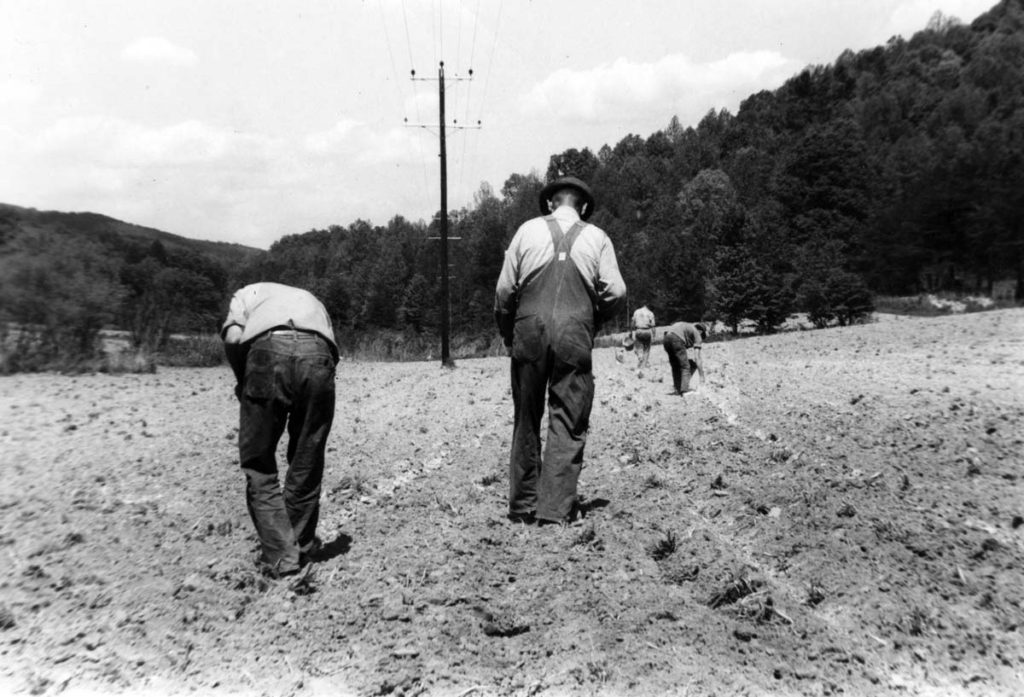Pine Mountain Settlement School
Series 11: FARM and FARMING
1913 – present

Jess Patterson with back to the camera, middle. VII 63 Life Work Maintenance, Farm, Grounds. [VII_63_life_work_001-8.jpg]
TAGS: farm overview, farms, agricultural practice, farming, farmland, farmers, Katherine Pettit, sowing, farm animals, Ayrshires, PMSS farm history, Mary Rockwell Hook, foodways, dairy, Agricultural Department of State University (University of Kentucky), J.H. Arnold, Boarding School farm, corn, sorghum, molasses, maple syrup, tree farming, forests, James Adoniram Burgess, industrial training, farm bibliography, Mary Rockwell Hook, land use, Jess Patterson
FARM and FARMING Overview
FARMING at Pine Mountain
Planning for Pine Mountain was very deliberate, and where land was involved, Katherine Pettit, Co-founder of the School, was a keen observer and a diligent doer. Of the two co-founders, Katherine Pettit and Ethel de Long, it was Pettit who assumed the lead responsibility for the farm and the land issues and agricultural promise of the School. Under Pettit’s direction, the land was to support the School, but it was also to be a driving force in the school’s educational programs. In her vision, the land would be a source for better agricultural practice, physical well-being, emotional temperance, and basic food needs of the school.
The forests, gardens, planting fields, grazing fields, flower beds – all received careful consideration from staff as well as students under her watchful eye. There is no doubt that the vision for the school’s physical site was always in Katherine Pettit’s mind’s eye, but she also called on her excellent co-founders, particularly Uncle William Creech. If she didn’t find her answers in nearby staff or in the community folk, she did not hesitate to seek local and outside consultation from experts in the field of agricultural practice.
The year1913 opened with the first visit to the campus of one of the most important of her farm consultants, Miss Mary Rockwell, an architect from Kansas City [Following her marriage, Mary Rockwell Hook] Together, Pettit, Ethel de Long, and Mary Rockwell developed a growth plan that centered on the topography of the land and its agricultural potential. The initial plan, according to Evelyn Wells, the first chronicler of the school’s history, was followed very closely.
Every effort was made to construct the buildings around the productivity of the land; to use what the land provided and what the topography suggested. Forest lumber, stone from the fields, native plants and flowers, local human and animal labor, native seeds for garden crops, and other native resources were called into use. All elements were considered important to the aesthetics of the place and to the growth of the school and its environs. The dreams were large. The remote location demanded that the planners seek local solutions to many of their needs, but Pettit called in some of the best agricultural consultants she could engage. These early expert resources modeled the latest research and advice available at the time. If they were to be both practical and educational in their mission to build a model “Settlement School”, Pettit insisted that they start with expert advice. The work of Pettit and her team shows a solid local focus. It was not an escape from the outside world, but a full exploration of what the outside world could bring to the dream.
While Pettit was in charge at the School, she repeatedly tapped into her expert contacts for advice and for all they could contribute. Her correspondence regarding the agricultural potential and the science of working with new land and architectural choices were remarkably intuitive for a woman of that time and the enthusiasm of the women around her showed equal enthusiasm and often even more remarkable intuitions and talent.
While Mary Rockwell Hook, a pioneering architect, was helping to develop an architectural plan for the land and how the buildings would interact with the landscape, Pettit’s other consultants were also called upon for direct assistance with the interactive site plan. James Adoniram Burgess, a Superintendent of Construction of buildings, a woodworker and the vocational instructor at Berea College (started in 1901), was well informed about construction techniques and was heavily consulted by Pettit. Pettit also consulted with the Agricultural Department of State University (early University of Kentucky), specifically J.H. Arnold, who had written extensively on factors necessary for successful farm management. While Arnold’s focus was on the Blue Grass area of the state and apple farming, he had sound recommendations for the business side of agriculture. In 1917 he co-wrote with W.D. Nicholls, USDA Bulletin No. 210 “Important Factors for Successful Farming in the Blue Grass Region of Kentucky.” This unique partnering of Burgess and Arnold was evidently very productive. Ethel de Long notes in her May 1913 Letter to Friends, that the consultants
… were here last week … to give us their advice on the best use of our land and the best disposal of the buildings we hope to have in the course of time. …..
FOR EDUCATORS: (a representative list OF SOURCES)
For a broader perspective on early farming practice in Appalachia during the early years of the twentieth century, see the following National Archives Catalog resources
Publicity Files, 1936 – 1938 in the Records of the Natural Resources Conservation Service (Record Group 114)
General Correspondence Files 1927-1951 in the Records of the Bureau of Entomology and Plant Quarantine (Record Group 7)
Records of the Bureau of Human Nutrition and Home Economics (Record Group 176) — See especially the Radio Broadcasts and the Correspondence and Cookbooks Related to Aunt Sammy’s Radio Recipes, 1931 – ca. 1954.
TO LEARN MORE ABOUT THE EARLY AGRICULTURAL YEARS AT PINE MOUNTAIN – SEE:
DANCING IN THE CABBAGE PATCH Farming the Land Early Years 1913-1930
___________________________________________________________________________________
Go to
FARM Guide

